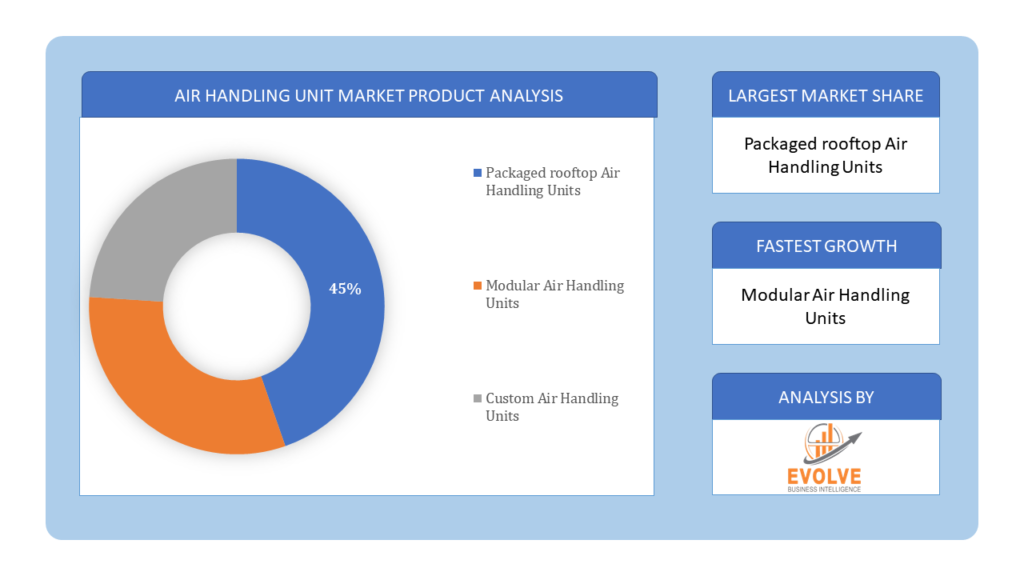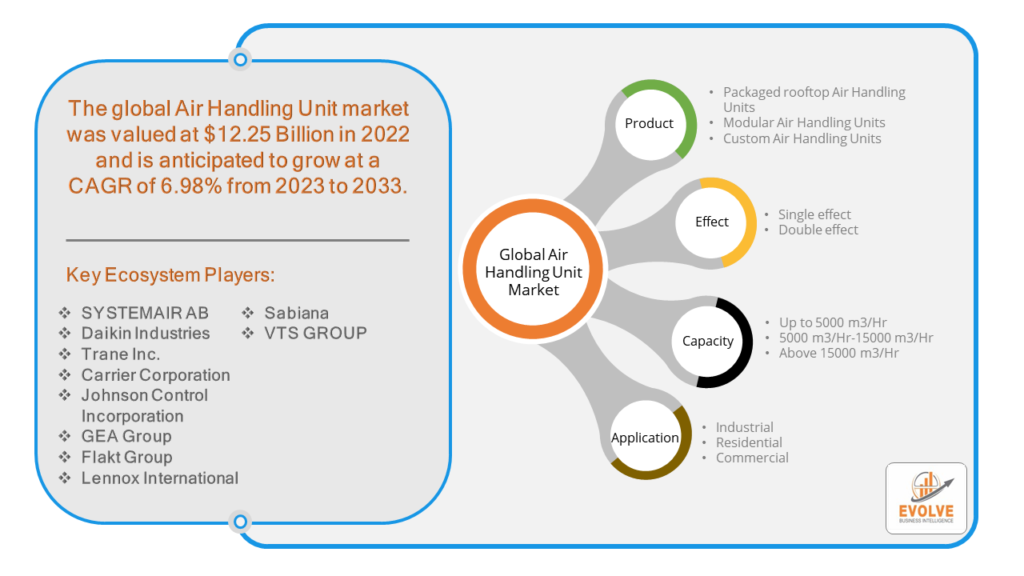Global Air Handling Unit Market Overview
The global Air Handling Unit market was valued at $12.25 Billion in 2022 and is anticipated to grow at a CAGR of 6.98% from 2023 to 2033. The Global Air Handling Unit (AHU) Market refers to the collective market for equipment used in heating, ventilation, and air conditioning (HVAC) systems. AHUs are essential components of HVAC systems, responsible for regulating and circulating air within buildings, ensuring proper ventilation, temperature control, and air quality.
The market encompasses various types of air handling units, including rooftop AHUs, ceiling-mounted AHUs, packaged AHUs, and others, each designed for specific applications and environments. Factors driving the growth of the Global AHU Market include increasing demand for energy-efficient HVAC systems, growing awareness about indoor air quality, stringent government regulations regarding energy efficiency and environmental sustainability, and rapid urbanization leading to the construction of new buildings.
The market is characterized by intense competition among key players, technological advancements, product innovations, and strategic collaborations. Additionally, factors such as economic conditions, construction activities, and regulatory policies influence the growth and dynamics of the Global AHU Market.
Global Air Handling Unit Market Synopsis
The COVID-19 pandemic had several significant impacts on the Global Air Handling Unit (AHU) Market. The pandemic disrupted global supply chains, leading to delays in the manufacturing and delivery of AHU components and equipment. Restrictions on movement, closure of factories, and transportation challenges hindered the supply of raw materials and finished products. With more people working remotely and spending time indoors, there has been a shift in demand dynamics for HVAC systems. While demand for AHUs in commercial buildings decreased, there was a relatively stable or even increased demand in sectors such as healthcare facilities, data centers, and residential buildings where proper ventilation and air quality are critical. The pandemic highlighted the importance of indoor air quality in preventing the spread of airborne viruses. This increased awareness has led to a greater emphasis on HVAC systems equipped with high-efficiency air filters, UV-C disinfection systems, and other technologies to improve indoor air quality. Consequently, there has been growing interest in upgrading existing AHUs or installing new ones with advanced filtration and purification capabilities.
Global Air Handling Unit Market Dynamics
The major factors that have impacted the growth of Global Air Handling Unit Market are as follows:
Drivers:
Rising Demand for Energy-Efficient Solutions
Increasing awareness of energy conservation and sustainability drives the adoption of energy-efficient HVAC systems, including AHUs. Governments worldwide implement regulations and incentives to encourage the use of energy-efficient equipment, spurring market growth. Heightened awareness of indoor air quality, particularly in commercial and healthcare settings, propels the demand for AHUs equipped with advanced filtration and purification technologies. Concerns about airborne pollutants, allergens, and pathogens drive the market for AHUs with superior IAQ capabilities. Ongoing technological innovations in HVAC systems lead to the development of more efficient, intelligent, and connected AHUs. Features such as variable air volume (VAV) control, integrated sensors, and remote monitoring enhance performance, control, and maintenance efficiency, driving market growth.
Restraint:
- Perception of High Initial Investment Costs
The upfront costs associated with purchasing and installing AHU systems can be substantial, particularly for large-scale projects or buildings with complex HVAC requirements. High initial investment costs may deter potential buyers or delay projects, especially in regions with budget constraints or economic uncertainties. AHU systems require regular maintenance and operational expenses, including filter replacements, energy consumption, and ongoing servicing. These expenses can add up over the system’s lifecycle and may pose challenges for budget-conscious building owners or operators, especially in cost-sensitive markets.
Opportunity:
⮚ Growing demand for Indoor Air Quality (IAQ)
Growing awareness of indoor air quality issues, particularly in commercial, healthcare, and educational facilities, presents opportunities for AHU manufacturers to provide solutions that improve IAQ. Developing AHUs with advanced filtration, UV-C disinfection, and air purification technologies can meet the demand for healthier indoor environments. Continued innovation in AHU technology, such as smart controls, IoT integration, and predictive maintenance capabilities, offers opportunities for differentiation and market leadership. Manufacturers investing in research and development to enhance product performance, reliability, and user experience can gain a competitive edge in the market. Urbanization trends and increasing urban populations drive demand for residential and commercial buildings equipped with modern HVAC systems. AHU manufacturers can target urban markets with solutions designed to optimize space, energy efficiency, and comfort in high-density environments.
Global Air Handling Unit Market Segment Overview
By Product
 Based on Product, the market is segmented based on packaged rooftop Air Handling Units, Modular Air Handling Units and Custom Air Handling Units. The packaged rooftop is projected to dominate the Air Handling Units Market. A packaged rooftop unit contains all the components needed to provide conditioned air in one compact unit. Packaged rooftop Air Handling Units are very popular with retail and industrial properties. As these units are mounted on the roof, this removes the concern about creating extra space or room for fitting it as is the case for the other types of AHU.
Based on Product, the market is segmented based on packaged rooftop Air Handling Units, Modular Air Handling Units and Custom Air Handling Units. The packaged rooftop is projected to dominate the Air Handling Units Market. A packaged rooftop unit contains all the components needed to provide conditioned air in one compact unit. Packaged rooftop Air Handling Units are very popular with retail and industrial properties. As these units are mounted on the roof, this removes the concern about creating extra space or room for fitting it as is the case for the other types of AHU.
By Effect
Based on Effect, the market segment has been divided into Single effect and Double effect. The double effect segment dominated the market and l. The Double Effect Air Handling Unit is a complete modular cooling solution. It provides high-performance, energy-efficient solutions for any environment and the user has complete control over the airflow both inside and outside their premises.
By Capacity
Based on Capacity, the market segment has been divided into Up to 5000 m3/Hr, 5000 m3/Hr-15000 m3/Hr and Above 15000 m3/Hr. The Upto 5000 m3/hr segment dominated the Global Air Handling Unit Market. AHUs in this capacity range are designed for easier installation and maintenance compared to larger units, making them suitable for applications where minimal downtime is critical.
By Application
Based on Application, the market segment has been divided into Industrial, Residential and Commercial. The commercial segment dominated the Global Air Handling Unit Market. The Expansion of commercial infrastructure globally, including office complexes, retail spaces, and hospitality establishments, drives the demand for HVAC systems and, consequently, air handling units.
Global Air Handling Unit Market Regional Analysis
Based on region, the Global Air Handling Unit Market has been divided into North America, Europe, Asia-Pacific, the Middle East & Africa, and Latin America. North America is projected to dominate the use of the Global Air Handling Unit Market followed by the Asia-Pacific and Europe regions.
Air Handling Unit North America Market
North America holds a dominant position in the Global Air Handling Unit Market. North America: United States and Canada: These countries have well-established construction industries and stringent building codes driving the demand for AHUs, particularly in commercial, institutional, and industrial sectors. Growing emphasis on energy efficiency and indoor air quality further boosts market growth. Technological advancements and adoption of smart building solutions contribute to market expansion.
Air Handling Unit Asia-Pacific Market
The Asia-Pacific region has indeed emerged as the fastest-growing market for the Global Air Handling Unit Market industry. The construction boom in China drives significant demand for AHUs, fueled by urbanization, infrastructure projects, and growing awareness of indoor air quality. Government initiatives promoting energy efficiency and green building standards further stimulate market growth. Rapid urbanization, industrialization, and infrastructure development contribute to the expansion of the AHU market in India. Increasing investments in commercial real estate, healthcare facilities, and data centers drive demand for HVAC solutions.
Competitive Landscape
The Global Air Handling Unit Market is highly competitive, with numerous players offering a wide range of software solutions. The competitive landscape is characterized by the presence of established companies, as well as emerging startups and niche players. To increase their market position and attract a wide consumer base, the businesses are employing various strategies, such as product launches, and strategic alliances.
Prominent Players:
- SYSTEMAIR AB
- Daikin Industries
- Trane Inc.
- Carrier Corporation
- Johnson Control Incorporation
- GEA Group
- Flakt Group
- Lennox International
- Sabiana
- VTS GROUP
Key Development
In January 2022, Johnson Control announced the launch of OpenBlue Indoor Air Quality as a Service for buildings, delivering energy-efficient, turnkey clean air outcomes with an innovative financing model.
December 2021: Trane announced the introduction of new digital indoor environmental quality (IEQ) management solutions. These provide building owners and facility managers with actionable insights for healthier and more efficient indoor spaces and occupant peace of mind.
Scope of the Report
Global Air Handling Unit Market, by Product
- Packaged rooftop Air Handling Units
- Modular Air Handling Units
- Custom Air Handling Units
Global Air Handling Unit Market, by Effect
- Single effect
- Double effect
Global Air Handling Unit Market, by Capacity
- Up to 5000 m3/Hr
- 5000 m3/Hr-15000 m3/Hr
- Above 15000 m3/Hr
Global Air Handling Unit Market, by Application
- Industrial
- Residential
- Commercial
Global Air Handling Unit Market, by Region
- North America
- US
- Canada
- Mexico
- Europe
- UK
- Germany
- France
- Italy
- Spain
- Benelux
- Nordic
- Rest of Europe
- Asia Pacific
- China
- Japan
- South Korea
- Indonesia
- Austalia
- Malaysia
- India
- Rest of Asia Pacific
- South America
- Brazil
- Argentina
- Rest of SouthAmerica
- Middle East &Africa
- Saudi Arabia
- UAE
- Egypt
- SouthAfrica
- Rest of Middle East & Africa
| Parameters | Indicators |
|---|---|
| Market Size | 2033: $12.25 Billion |
| CAGR | 6.98% CAGR (2023-2033) |
| Base year | 2022 |
| Forecast Period | 2023-2033 |
| Historical Data | 2021 |
| Report Coverage | Revenue Forecast, Competitive Landscape, Growth Factors, and Trends |
| Key Segmentations | Product, Effect, Capacity, Application |
| Geographies Covered | North America, Europe, Asia-Pacific, Latin America, Middle East, Africa |
| Key Vendors | SYSTEMAIR AB, Daikin Industries, Trane Inc., Carrier Corporation, Johnson Control Incorporation, GEA Group, Flakt Group, Lennox International, Sabiana and VTS GROUP. |
| Key Market Opportunities | • Growing demand for Indoor Air Quality (IAQ) • Urbanization and Building Renovations |
| Key Market Drivers | • Rising Demand for Energy-Efficient Solutions • Technological Advancements |
REPORT CONTENT BRIEF:
- High-level analysis of the current and future Global Air Handling Unit Market trends and opportunities
- Detailed analysis of current market drivers, restraining factors, and opportunities in the future
- Global Air Handling Unit Market historical market size for the year 2021, and forecast from 2023 to 2033
- Global Air Handling Unit Market share analysis at each product level
- Competitor analysis with detailed insight into its product segment, Government & Defense strength, and strategies adopted.
- Identifies key strategies adopted including product launches and developments, mergers and acquisitions, joint ventures, collaborations, and partnerships as well as funding taken and investment done, among others.
- To identify and understand the various factors involved in the global Air Handling Unit Market affected by the pandemic
- To provide a detailed insight into the major companies operating in the market. The profiling will include the Government & Defense health of the company’s past 2-3 years with segmental and regional revenue breakup, product offering, recent developments, SWOT analysis, and key strategies.







